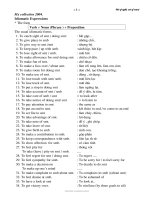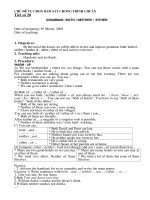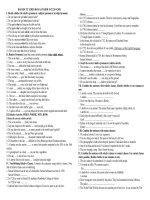Tự Chọn Bám Sát 7 (10) - Relative Clauses
Bạn đang xem bản rút gọn của tài liệu. Xem và tải ngay bản đầy đủ của tài liệu tại đây (94.86 KB, 2 trang )
BÀI HỌC TỰ CHỌN-BÁM SÁT KHỐI 10 (7) 25-9-2010
I. Decide whether the relative pronoun is a subject pronoun or an object pronoun.
1. Do you know the girl who I danced with?
2. Do you know the girl who danced with me?
3. The apples that are lying on the table are bad.
4. The apples that we bought in the shop are bad.
5. We will stay at a hotel which is not far from the beach.
6. We will stay at a hotel which my friend has recommended to us.
7. That is a museum which I like very much.
8. That is a museum which lies in the heart of the town.
9. This is the man who Barbara visited in Scotland.
10. This is the man who lives in Scotland.
II. Relative Pronouns. Insert the correct relative pronoun (who, which, whose).
1. This is the bank .........was robbed yesterday.
2. A boy .........sister is in my class was in the bank at that time.
3. The man .........robbed the bank had two pistols.
4. He wore a mask .........made him look like Mickey Mouse.
5. He came with a friend .........waited outside in the car.
6. The woman .........gave him the money was young.
7. The bag .........contained the money was yellow.
8. The people .........were in the bank were very frightened.
9. A man .........mobile was ringing did not know what to do.
10. A woman .........daughter was crying tried to calm her.
11. The car .........the bank robbers escaped in was orange.
12. The robber......... mask was obviously too big didn't drive.
13. The man drove the car .........was nervous.
14. He didn't wait at the traffic lights .........were red.
15. A police officer .........car was parked at the next corner stopped and arrested them.
III. Relative Adverbs (WHEN, WHERE, WHY, HOW)
Choose the correct relative adverb.
1. This is the station........ Emily met James.
2. July and August are the months........ most people go on holiday.
3. Do you know the reason .......so many people in the world learn English?
4. This is the church ....... Sue and Peter got married.
5. Edinburgh is the town .........Alexander Graham Bell was born.
6. 25 December is the day .......children in Great Britain get their Christmas presents.
7. A famine was the reason ......... so many Irish people emigrated to the USA in the 19th
century.
8. A greengrocer's is a shop ........you can buy vegetables.
9. The day .......I arrived was very nice.
10. A horror film was the reason ...... I couldn't sleep last night.
IV. Non-Defining Relative Clauses. Combine the sentences using relative clauses. Note that
all relative clauses are non-defining.
1. Samuel Johnson was the son of a bookseller. Samuel Johnson was born in 1709.
Samuel Johnson ................
2. In 1728, he went to Oxford. He studied at Pembroke College in Oxford.
In 1728, he went ................
3. Johnson had to leave Oxford without a degree. He was too poor to pay the fees.
Johnson ................
4. In 1737, Johnson moved to London. There he wrote poetry, essays and biographies.
In 1737, Johnson ................
5. In 1746, Johnson started to write his dictionary. It took him nine years to complete.
In 1746, Johnson started ................
6. His home at that time was in 17 Gough Square in London. It is a museum now.
17 Gough Square in London ................
7. In this house, his wife died in 1752. Her name was Elizabeth Porter.
In this house his wife
8. In 1755, the work was published. It was called A Dictionary of the English Language.
In 1755, the work ................
9. Samuel Johnson died in 1784. He is buried in Westminster Abbey.
Samuel Johnson ................
V. Insert the correct relative pronoun or relative adverb.
1. The woman........... is sitting at the desk is Mr Winter's secretary.
2. I cannot remember the reason .........he wanted us to leave.
3. Jane, ...........mother is a physician, is very good at biology.
4. She didn’t see the snake .........was lying on the ground.
5. Do you know the shop .........Andrew picked me up?
VII. Combine the sentences with relative clauses. (Decide whether to use commas or not.)
1. A monk is a man. The man has devoted his life to God.
A monk .............................................................
2. I have one black cat. His name is Blacky.
I have ...............................................................
3. A herbivore is an animal. The animal feeds upon vegetation. [động vật ăn cỏ]
A herbivore .......................................................
4. Carol plays the piano brilliantly. She is only 9 years old.
Carol ..................................................................
5. Sydney is the largest Australian city. It is not the capital of Australia.
Sydney ................................................................
VIII. Combine the sentences with contact clauses.
1. We ordered a book. It was very expensive.
2. You are sitting on a bench. The paint on the bench is still wet.
3. The photographer could not develop the pictures. I had taken them in Australia.
4. One of the bins smells awful. You haven’t emptied the bin for 3 weeks.
5. They are singing a song. I don’t know the song.
IX. Combine the sentences with relative clauses or contact clauses. Use contact clauses
where possible. (Decide whether to use commas or not.)
1. The city seems to be abandoned. It is usually crowded with people.
2. You made an offer. We cannot accept it.
We .......................................................
3. A midwife is a woman. She assists other women in childbirth.
A woman
4. Three youngsters were arrested by the police. They had committed criminal offences.
The police .......................................................
5. The World Wide Web has become an essential part of our lives. It was invented by Tim
Berners-Lee. → Tim Berners-Lee ......................................









